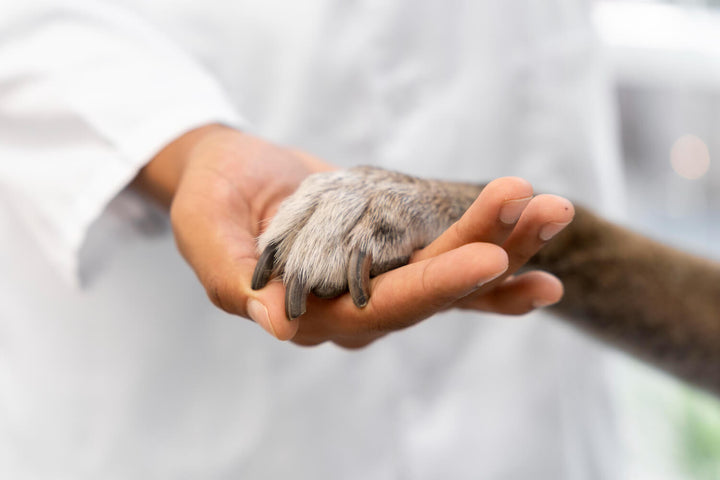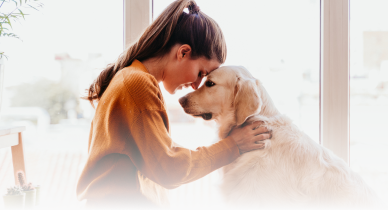When you think of dog breeds that embody both elegance and grandeur, the Great Dane is undoubtedly near the top of the list. These gentle giants are not only known for their towering stature but also for their affectionate and friendly nature. In this detailed description, we'll delve into the world of Great Danes, exploring their physical characteristics, notable traits, temperament, adaptability, suitability for different homes, care guidelines, training needs, and even their presence in history and pop culture.
Did You Know these Facts about the Great Dane?
-
Despite its name, the Great Dane doesn't hail from Denmark but rather from Germany, where it was initially bred for hunting boars.
-
Great Danes hold the Guinness World Record for the world's tallest dog. The title was earned by a Great Dane named Zeus, who stood an astounding 44 inches tall at the shoulder.
-
The famous cartoon character Scooby-Doo, from the popular animated series, is said to be modeled after a Great Dane.
Despite their imposing stature, Great Danes are known for their gentle and affectionate nature, making them excellent family pets.
Unfortunately, Great Danes are also notorious for their drooling tendencies, so be prepared to keep a towel handy.
Great Danes, while not the most numerous of breeds, enjoy steady popularity, particularly in the United States. In 2022, they reached position #19 in the American Kennel Club's popularity list, drawing attention with their noble appearance and friendly disposition.

Traits of the Great Dane Breed
Personality. Great Danes are known for their gentle and friendly personalities. They are often referred to as "gentle giants" due to their calm and well-mannered nature. They are affectionate and loyal, making them great companions.
Family Life. These dogs thrive in family settings. They are good with children and are protective without being aggressive. Great Danes often consider themselves as lap dogs, despite their size.
Appearance. Great Danes are impressively large dogs with a well-muscled, athletic build. They have a short coat that comes in various colors, including brindle, fawn, blue, black, and harlequin. They can have striking markings such as a black mask or white "socks" on their paws.
Sociability. Great Danes are social dogs and enjoy human companionship. They may be reserved around strangers, but with proper socialization, they can be quite sociable.
Average Sizes & Life Expectancy
- Height: 28 to 34 inches tall (71 to 86 cm)
- Weight: 140 to 175 pounds (63 to 80 kg)
- Life Expectancy: Around 7 to 10 years
Detailed Description of the Great Dane Breed
Appearance. Great Danes are true giants among dogs. They have a well-muscled and athletic build that combines strength with grace. Great Danes typically stand between 28 to 34 inches at the shoulder, with males being larger than females. These dogs are heavyweights, often weighing between 140 to 175 pounds or even more. They have a short and smooth coat that can come in a variety of colors, including brindle, fawn, blue, black, and harlequin (white with irregular black patches).
Great Danes usually have expressive, dark eyes that radiate kindness and intelligence. Their ears are medium in size and can be cropped or left natural. And their tail is long and tapers to a point.
Temperament. Great Danes thrive on human companionship and enjoy being part of the family. They are typically easygoing and even-tempered. Despite their size, they can be playful and enjoy interactive activities with their family.
Great Danes are generally adaptable to different living environments as long as they have sufficient space to move around.
They can be reserved around strangers, but they are not aggressive by nature. Proper socialization is key to ensure they are well-adjusted around new people and situations.
Adaptability. Great Danes can be wonderful family dogs. They are good with children and often protective of them. They also make excellent companions for individuals and couples who have the space and time to dedicate to this breed.
While Great Danes are adaptable and can live in apartments, they thrive in homes with larger spaces where they can stretch their legs.
Regular exercise is essential, but surprisingly they don't require as much activity as some smaller, more energetic breeds.
Care Guidelines. A balanced diet that meets their specific needs is crucial for Great Danes, as they are prone to certain health issues. Consult your vet for guidance.
Regular veterinary check-ups are essential for monitoring their health.
Their short coat is easy to maintain and requires minimal grooming. Regular brushing can help reduce shedding.
Training Strategies. Consistent and positive training methods work best with Great Danes. Early socialization is crucial to ensure they grow up well-adjusted.
Notable in History and Pop Culture. Great Danes have a rich history that dates back to ancient civilizations. They were originally bred in Germany for hunting large game, such as wild boars.
Several famous individuals, including celebrities and historical figures, have owned Great Danes. Their imposing yet gentle presence has made them popular in various forms of media.
In conclusion, the Great Dane is a breed that combines an impressive physical presence with a heartwarming and gentle personality.
Their adaptability, loyalty, and affectionate nature make them a cherished addition to many homes, and their history and influence in pop culture only add to their appeal.
What to expect when living with the Great Dane Breed
Personality. They are often referred to as "gentle giants" for a reason. Despite their imposing size, they are remarkably gentle and loving, making them excellent companions for families.
Great Danes are fiercely loyal to their families. They form strong bonds and are always eager to be close to their loved ones. While they are generally friendly, they can be reserved around strangers.
Proper socialization from a young age is essential to ensure they remain well-mannered and confident in new situations.
Great Danes have a protective instinct that makes them watchful guardians. They can be relied upon to alert their family to any potential threats.
Ideal Environment. They are suitable for both apartments and houses, but they truly thrive in homes with ample space.
A securely fenced yard allows them to exercise and play freely. While they are not overly active, regular exercise is vital to keep them healthy and prevent obesity.
Daily walks and some playtime in the yard are usually sufficient. Their short coat doesn't provide much insulation against cold weather. In colder climates, consider providing them with a doggy sweater during walks.
Maintenance Level. Great Danes have a short and smooth coat that is relatively low-maintenance. Weekly brushing helps reduce shedding, and baths are only needed as necessary.
Overall Health Expectations and Best Health Tests for the Great Dane Breed
Health Considerations. Great Danes are generally healthy dogs, but like all breeds, they are susceptible to specific health issues. They can be prone to bloat (gastric torsion), hip dysplasia, heart issues, and certain genetic conditions. Regular vet visits can help monitor and address these concerns.
Recommended Health Tests. Responsible breeding involves health screening for these conditions. Ensure that the breeder you choose conducts health tests on the parent dogs to reduce the risk of passing on genetic disorders.
Best Nutrition, Diet & Supplements for the Great Dane Breed
Nutrition and Diet. Great Danes need a diet rich in high-quality protein to support their muscle development and overall health. Look for dog foods with protein sources like chicken, turkey, or fish.
They also require a moderate amount of healthy fats for energy. Fats from sources like salmon oil and flaxseed help maintain their coat and skin.
Due to their size, they consume a significant amount of calories (male adults consume between 8 and 10 cups of food daily). However, avoid overfeeding to prevent obesity, which can lead to health issues.
While carbohydrates are essential, opt for foods with whole grains like brown rice and sweet potatoes. These provide sustained energy and essential fiber.
To prevent bloat, avoid vigorous exercise and playtime immediately after meals. Wait at least an hour before allowing strenuous activity.
Hydration is Key. Adequate hydration is essential for Great Danes. Encourage your dog to drink plenty of water.
Supplements. While Great Danes can receive essential nutrients from a balanced diet, some supplements can support their overall health.
Omega-3 fatty acids, such as fish oil, can help maintain healthy skin and coat. Additionally, consider supplements like glucosamine and chondroitin to support joint health, as Great Danes can be prone to hip dysplasia.
Foods to Avoid. Large kibble sizes can help prevent bloat and ensure proper chewing.
Avoid excessive calcium intake, as it may contribute to skeletal issues in growing puppies.
Never feed your Great Dane foods
like chocolate, grapes, onions, or garlic, which can be toxic to dogs.
Grooming Requirements for the Great Dane Breed
Coat Maintenance and Shedding. Great Danes boast a short, sleek coat that requires minimal grooming compared to longer-haired breeds. Weekly brushing with a soft-bristle brush helps remove loose hair and distribute natural oils for a shiny coat.While their coat is short, Great Danes are moderate shedders. Brushing helps minimize loose hair around your home.
Paw Care and Hygiene. Regular nail trims are essential. Aim to trim every 4-6 weeks, as long nails can cause discomfort and affect their gait. Great Danes have large, sensitive paws. Regularly inspect their paws for injuries, thorns, or foreign objects.Trim the fur between their paw pads to prevent matting and improve traction.
Ear Care. Check their ears weekly for dirt, wax buildup, or signs of infection. Clean them as needed with a dog-specific ear cleaner.
Bathing Frequency. Only bathe your Dane as needed, typically every 2-3 months or when they get dirty. Use a mild dog shampoo to avoid skin irritation.
Exercise Required for the Great Dane Breed
Despite their size, Great Danes are surprisingly adaptable and don't require excessive exercise. A daily 30-minute to 1-hour walk or playtime in a secure yard is sufficient. Avoid strenuous exercise, especially during puppyhood when their bones are still developing, to prevent joint and ligament issues.
Mental exercise is equally important. Puzzle toys and obedience training sessions can keep their minds engaged. If you have access to a safe swimming area, many Danes enjoy swimming, which is an excellent low-impact exercise.
Training Tips for the Great Dane Breed
Great Danes are intelligent and highly trainable dogs. Effective training is crucial to channel their energy and ensure they are well-behaved companions.
Do…
-
Use Rositive Reinforcement. Great Danes respond well to positive reinforcement training methods. Use treats, praise, and toys as rewards for good behavior.
Start socializing your Great Dane from an early age to ensure they're comfortable around people, pets, and various environments.
Enroll them in Obedience Training. Basic obedience training is essential to ensure your Great Dane is well-behaved and can respond to commands like "sit," "stay," and "come."
Due to their size, leash training is crucial. Teach them to walk on a loose leash to prevent pulling.
Don't…
- Use physical punishments or yelling as it can damage the trust between you and your dog.
- Skip training; consistency is vital. Skipping training sessions can lead to behavioral issues.
- Forget about mental and physical health. Dobermanns require both mental and physical stimulation, so neglecting exercise can lead to boredom and destructive behavior.
- Lose your patience. Great Danes are gentle giants, but they can be stubborn. Be patient and consistent with your training.
The Great Dane Breed is Suitable For
-
While it's a common misconception that you need a mansion to accommodate a Great Dane, they are surprisingly well-suited for homes with yards, even if they are modest in size.
Great Danes are generally calm indoors and don't require excessive space. However, access to a secure outdoor area for exercise and play is essential.
Great Danes are often referred to as "gentle giants." They have a patient and affectionate nature, making them excellent companions for families with children. Their size can be a bonus as they often become protective playmates for kids.
Great Danes are social dogs and typically get along well with other pets, including dogs and cats. Proper socialization from a young age can help ensure harmony among your furry family members.
Surprisingly, Great Danes can adapt to apartment living if their exercise needs are met. They are generally quiet indoors and are content with lounging as long as they get their daily walks.
The Great Dane Breed is Not Suitable For
Cramped living conditions, such as tiny apartments or houses without any outdoor area, can be stressful for a Great Dane. They need room to stretch their legs. Great Danes are sensitive to extreme heat due to their short coats and minimal fat insulation. If you live in a hot climate, you'll need to take extra precautions to keep them cool.
While they do need exercise, intensive workouts, like marathon runs, are not suitable for Great Danes, especially when they are young. Excessive exercise can harm their growing joints.
Famous Great Dane Owners
-
Will Ferrell - Known for his hilarious roles in movies like "Anchorman" and "Talladega Nights," Will Ferrell is also a proud owner of a Great Dane. His love for the breed reflects their gentle and loving nature.
-
J. Paul Getty - The billionaire was known for his extensive art collection and philanthropic efforts. He was also a fan of Great Danes and had several as companions.
- Edna Ferber - The renowned author of classics like "Giant" and "Show Boat" had a deep affection for Great Danes. Her love for the breed is evident in her writings.
Accomplishments of the Great Dane Breed
Great Danes have held several world records, including "Tallest Dog Ever Recorded." Zeus, a Great Dane, held this record, standing at a staggering 44 inches tall at the shoulder.
These gentle giants have made appearances in numerous movies and TV shows, often cast as loyal and lovable characters. Scooby-Doo, the famous animated detective dog, is often said to be based on the Great Dane breed.
Due to their calm temperament and size, Great Danes are often used as therapy dogs, providing emotional support to those in need. They have also been employed as service dogs, assisting individuals with disabilities.
The History of the Great Dane Breed
Creation and Purpose. The Great Dane's ancestors can be traced back to ancient Egypt, where engravings of dogs resembling Great Danes were found on monuments dating back over 5,000 years. These early dogs were used for hunting and guarding. In Europe, particularly in Germany, the breed was refined over centuries.
They were initially known as "Deutsche Dogge," meaning German Mastiff. These dogs served multiple purposes, including hunting large game such as boars and bears. Their imposing size and strength made them formidable hunting companions and protectors of noble estates.
The breed was further developed in the 16th century by German nobility, who appreciated their loyalty and regal appearance. During this period, the Great Dane's role transitioned from a fierce hunter to a gentle and loyal companion.
Early Roles and Evolution. In the 19th century, breeders in Germany, specifically a man named Karl Friedrich Louis Dobermann, played a significant role in refining the breed's characteristics. This led to the development of the sleek, elegant Great Dane we know today. The infusion of Greyhounds, Mastiffs, and Irish Wolfhounds contributed to their refined appearance.
With the name change from "Deutsche Dogge" to "Great Dane," there's an interesting story. In the 18th century, a French naturalist named Buffon visited Denmark and admired these dogs. He called them "le Grande Danois," or "Great Dane" in English, and the name stuck.
Changes and Modern Impact. During the late 19th and early 20th centuries, Great Danes gained popularity in the United States and were recognized by the American Kennel Club (AKC) in 1887. They quickly became a status symbol among the American elite. In modern times, Great Danes are cherished family pets known for their gentle and affectionate nature. They have also served as therapy dogs and even assisted people with disabilities due to their calm temperament and size.
The Great Dane's journey from a ferocious boar hunter to a beloved and regal companion dog is a testament to their adaptability and enduring appeal. Today, they continue to capture hearts with their imposing yet gentle presence.
The Great Dane Breed Standard
The Great Dane belongs to the Working Group according to the American Kennel Club (AKC). This group includes breeds that are known for their strength, intelligence, and versatility. Great Danes fit well in this category due to their history as hunters and protectors.
The AKC's formal Breed Standard for the Great Dane is a detailed description that serves as a benchmark for the ideal specimen of the breed. It covers aspects such as size, color, temperament, and conformation. You can find the complete AKC Breed Standard for Great Danes on the official AKC website.
The Great Dane Club of America (GDCA) is the national breed club dedicated to this majestic breed. They provide valuable resources, information, and support to Great Dane enthusiasts. You can visit their website at www.gdca.org for more information.
General Appearance
Head, Muzzle, Nose. The Great Dane boasts a distinctive head that exudes dignity and strength. It's broad and square, with a flat skull. The head should be in proportion to the dog's massive body. The expression is alert and intelligent, with dark, expressive eyes that convey a friendly and gentle nature.
The ears are medium-sized and set high, naturally folding forward. The muzzle is deep, powerful, and rectangular, blending seamlessly with the skull. The nose is broad and black, except in blue Danes where it's a solid blue color. In harlequin Danes, a black nose with white patches is acceptable. In fawn and brindle Danes, a black mask over the eyes and ears is preferred.
Teeth. Great Danes have a full set of strong, white teeth that meet in a scissors bite. Dental care is vital to maintain their oral health.
Neck. Their neck is long, muscular, and gracefully arched. It blends harmoniously into the shoulders, adding to their elegant appearance.
Body. The body of a Great Dane is a masterpiece of balance and proportion. The chest is deep and broad, reaching the elbow. The back is straight, strong, and level. The ribs are well-sprung but not barrel-like. Danes have a short, strong loin and a gently sloping croup. Their well-developed abdomen is neither tucked up nor excessively pendulous.
Tail. The tail of a Great Dane is thick at the base and tapers toward the end. It's set high and, at rest, hangs down with a slight curve. When alert or in motion, it rises but should not curl over the back.
Coat. Great Danes have a short, dense coat that lies flat against their body. It's sleek and easy to care for. Coat colors vary and include fawn, brindle, blue, black, harlequin, and mantle. Some Danes may have a white chest and feet.
Size. Size is where Great Danes truly stand out. They are one of the tallest breeds in the canine kingdom. Males typically stand between 30 to 34 inches at the shoulder, while females are slightly smaller, ranging from 28 to 32 inches. These majestic dogs can weigh anywhere from 140 to 175 pounds, with some individuals exceeding even these impressive figures.
Gait. Great Danes have a smooth, powerful, and coordinated gait. Their stride is free and ground-covering, showing good reach in the front and strong drive in the rear. When viewed from the front or rear, their legs move in a straight line. As speed increases, they tend to single-track. Overall, their gait is efficient and graceful for a dog of their immense size.
Reputable Breeders
For those seeking a well-bred Dane, there are reputable breeders who prioritize health, temperament, and the breed's standard. Here are a few notable breeders:
Top Shelters for Adoption
Adopting a dog can be a rewarding experience. Here are a few shelters where you might find a Dane in need of a loving home:
Top 5 Frequently Asked Questions & Answers about the Great Dane Breed
What is the average lifespan of a Great Dane?
Great Danes typically live around 7 to 10 years.
Do they require a lot of exercise?
Yes, Great Danes are an active breed and need regular exercise to stay healthy and happy.
Are Great Danes good with children?
Yes, they are known for their gentle and friendly nature, making them good family pets.
How big do Great Danes get?
Great Danes are one of the largest dog breeds, with males reaching heights of 28 to 34 inches at the shoulder.
Do they shed a lot?
Great Danes have short coats and are considered moderate shedders.
A Final Tip for Bringing a Great Dane into Your Life
Bringing a Great Dane into your life can be an incredibly rewarding experience. These gentle giants are known for their affectionate and loyal nature. However, due to their size, they require space and regular exercise. Socialization and early training are crucial to ensure they grow into well-mannered companions. With proper care and attention, Great Danes can become cherished members of your family, providing abundant love and companionship.
Valuable Resources for Your Journey to Parenting a Great Dane
At Felicitails you will find many wonderful services, supplies and guides for your life ahead with a loving pup at your side.

Hope You Enjoyed The Read!
Tag Cloud

A warm welcome from Lindsay & Huck (my English Pointer). Hope you enjoy the read and find just what you are looking for when it comes to living your best life with your loved pets.

-
Dog Breeds
(42)
-
Emotional Support Animals
(10)
-
Dog Grooming
(6)
-
Dog Health
(18)
-
Life with a Dog
(18)
-
Dog Nutrition
(11)
-
Service Animals
(11)
-
Dog Training
(5)







